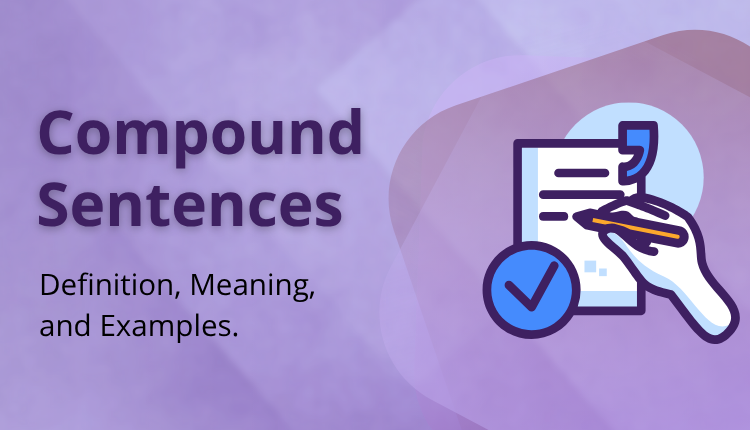Do you want to take your writing to the next level? Compounding your sentences is the key. Not only do they add style, but also precision to your thoughts. Whether you’re writing an essay, authoring a book, or just talking smarter, comprehending the compound sentence can make a huge difference. Let’s get into why these sentences are so effective and how they can change your writing forever.
What is a compound sentence?
A compound sentence is a sentence that joins two independent clauses. These clauses are joined through coordinating conjunctions like “and,” “but,” or “or.” This makes it possible to express more involved thoughts in a single statement.
For instance, if we take the sentences “I enjoy reading” and “I love going for walks,” they become a compound sentence once they are joined together: “I enjoy reading, and I love going for walks.” This relationship adds depth to the text and reaches readers well.
Definition of a Compound Sentence
A compound sentence is a sentence that has two or more independent clauses. Each is a complete thought on its own, but they are combined with coordinating conjunctions such as “and“, “but” or “or.”
This framework brings diversity and depth into writing. It gives room for the development of intricate ideas in a straightforward way, which improves readability as well as interest. Knowing this definition goes a long way in enhancing your writing capabilities while making your communication process rich.
Examples of compound sentences
Compound sentences properly join ideas that are similar. For example, “I wanted to take a walk, but it began to rain.” Two independent clauses are joined with the word “but” in this sentence.
Another is, “She enjoys painting, and he plays the guitar.” This sentence joins two activities enjoyed by two subjects. With the use of compound sentences such as these, you can construct more interesting and dynamic writing that has a good flow.
Rules of compound sentences
In building compound sentences, coordinating conjunctions should be used correctly. Examples of these coordinating conjunctions include “and,” “but,” “or,” among others. They must link two independent clauses smoothly together.
Punctuation is just as important. A comma needs to come before the coordinating conjunction when combining two complete thoughts. For instance: “I love reading, and my sister loves writing.” Obeying these rules increases understanding and maintains your writing refined while communicating your ideas effectively.
Common mistakes with compound sentences
One of the most frequent mistakes with compound sentences is misusing coordinating conjunctions. A lot of students forget to put a comma before “and,” “but,” or “or” when they are linking two independent clauses, resulting in run-on sentences.
Another frequent error occurs when subordinate clauses are mistakenly treated as independent ones. This can confuse readers and disrupt the flow of the writing. Paying close attention to these details ensures clarity and enhances sentence structure in your work.
Compound vs. complex sentences
Compound sentences consist of two or more independent clauses connected by coordinating conjunctions like “and,” “but” or “or“. They express multiple ideas with equal weight, allowing for a smooth flow in writing.
While simple sentences include only an independent clause, complex sentences have an independent clause and dependent clauses. The dependent clause provides extra information but can’t exist alone. Knowledge of both kinds of sentences enhances precision and diversity in your writing style and makes it more interesting for readers.
How Trinka Grammar Checker Can Help
Trinka Grammar Checker is a resourceful tool for fine-tuning your writing. It identifies grammatical errors in sentence construction, such as compound sentences. Through real-time suggestions, Trinka guarantees that your thoughts flow effortlessly and harmoniously.
With its easy-to-use interface, you are able to identify errors and improve clarity. AI-based recommendations guide you on how to build successful compound sentences and steer clear of the traps. By this, your writing continues to be engaging and impactful without compromising on quality or understanding.
Conclusion
Knowledge of compound sentences enhances your writing skills. They enhance variety and richness, enabling more subtle expression.
By being experts in their structure and procedures, you can raise your level of communication. From academic texts to informal speech, compound sentences applied to the fullest captivate the reader or listener. Discover this invaluable grammatical aid to produce greater clarity and refinement in your language.
Frequently Asked Questions
Compound sentences are a fundamental aspect of English grammar. They consist of two or more independent clauses connected by coordinating conjunctions like “and,” “but,” or “or.” Each clause can stand alone as a complete sentence, which adds depth to your writing. Using compound sentences allows for greater variety and complexity in expression. They help convey relationships between ideas more effectively, making your message clearer and engaging for readers. Understanding how to use them enriches both spoken and written communication.
A compound sentence is a type of grammatical structure that connects two independent clauses. These clauses are complete thoughts, each capable of standing alone as separate sentences. To form a compound sentence, you typically use coordinating conjunctions like “and,” “but,” or “or.” This allows for the combination of ideas in a clear and coherent way. By doing this, writers can convey more complex information without losing clarity.
Examples of compound sentences help illustrate their structure and function. For instance: “I wanted to take a walk, but it began raining,” “She enjoys reading novels, and he likes writing poetry,” and “The kids played outside until sundown, so we chose to take them inside.” These sentences show how two independent clauses can be joined by coordinating conjunctions like “and,” “but” or “so,” enhancing writing by adding variety and clarity.

